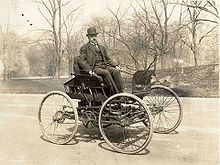Elwood Haynes
He invented the metal alloy stellite and independently co-discovered martensitic stainless steel along with Englishman Harry Brearley in 1912 and designed one of the earliest automobiles made in the United States.
He is recognized for having created the earliest American design that was feasible for mass production and, with the Apperson brothers, he formed the first company in the United States to produce automobiles profitably.
He began to formulate plans for a motorized vehicle in the early 1890s; he successfully road tested his first car, the Pioneer, on July 4, 1894—eight years after the first automobile was patented in Germany.
Working in his laboratory to develop new corrosion-resistant metals for auto parts, Haynes discovered that mixing tungsten with chromium, steel and iron resulted in the formation of strong and lightweight alloys that were impervious to corrosion, and could endure high temperatures.
After his death from complications arising from influenza, his Kokomo mansion was converted into the Elwood Haynes Museum and is open to the public where many of his original inventions and automobiles are on display.
[3] In 1866, the family moved from their two-room house in Portland into the countryside outside of town where they purchased a larger home to better accommodate their growing number of children.
[5] His early experiments and studies interested him in the fundamental properties of matter, and he was intrigued by how mixing compounds could create completely different alloys.
[18] His mother died in May 1885 and he decided to leave the university without completing his second year, as he was not working to attain a degree but only taking courses of interest.
After he had returned home again, he took a position at the newly established Eastern Indiana Normal School and Commercial College (now Ball State University) and served as the head of the chemistry department.
[21] As a professor at a university in the Trenton Field, Haynes offered his services to the drillers and worked to analyze soil samples, determine well pressure, and give estimates on the amount of energy that could be created by the gas.
[7][24] Haynes' reputation as an industry leader grew out of his operations at Portland and the Kokomo Democrat referred to him as "the only infallible authority on natural gas in eastern Indiana" in an 1889 article.
His thoughts on the topic were spurred by his need to regularly change horses because of their inability to endure the long distances and sandy roads he frequently traveled.
Haynes solved the problem by creating a refrigeration device that would cause the moisture (which was a diluted form of gasoline) to condense, freeze, and fall into a reservoir.
[26] Haynes was offered a higher ranking position within Indiana Gas at the Chicago headquarters, but by then he had become aware of the business's connection to the corrupt and disgraced monopolist Charles T. Yerkes.
[27][35] Haynes decided he needed a different facility to continue the experiment after his wife told him she would not abide his destruction of the family kitchen.
He agreed to work on his vehicle only after-hours, pay 40 cents per hour for the help of Elmer and his brother Edgar, and to not hold them responsible should his project fail.
A central column was built of steel and laid across the axles in such a way as to allow it move in all directions within a small radius to accommodate any sudden movements by the motor or vehicle.
[35][37] Haynes' car is believed to be the second gasoline-engine powered vehicle successfully road tested in the United States, according to its exhibit information at the Smithsonian Institution.
[36][40] The Sintz company continued to be intrigued by Haynes' use of their motor and sent representatives to photo his vehicle and published the images as an advertisement for one of their engine's possible uses.
Haynes and Edgar Apperson readily agreed to the demand and drove the car from Kokomo to Webber's New York home, the first time an automobile traveled over 1,000 miles (1,600 km).
He also investigated other areas and published a 1906 paper on the impurities in gasoline and recommended that the sulfur content in the fuel be lowered to increase engine performance.
[53] The celebration was intended to be a ten-year commemoration of the invention of the automobile, although earlier self-vehicles dated back nearly twenty years in Europe.
He continued to experiment with it until 1910 when he published his findings in a paper to the International Congress of Applied Chemistry and the American Institute of Metals, where he held memberships.
Haynes conceded their point, but submitted a second application and supplied a sample showing the stainlessness of his alloy when created using his exact proportions of metals, and it was granted.
[30] British metallurgist Harry Brearley independently produced an identical alloy around the same time and applied for an American patent and found that one already existed.
His statement was widely repeated and, although he claimed to have made it in jest, it alienated a large part of his workforce and began a period of labor problems.
[63] Harry Stewart New, the Republican candidate narrowly won the election by plurality, and Haynes was accused of costing Incumbent Democratic Senator John W. Kern's re-election.
In letters to friends and fellow prohibitionists, he ridiculed the organization for using violent and illegal tactics to achieve prohibition, and accused them of hypocrisy for supporting many anti-prohibition Democratic politicians.
[70] On January 6, 1925, Haynes, the Apperson brothers, and other automotive pioneers were awarded gold medals by the National Automobile Chamber of Commerce at a New York City auto exhibition for their contributions to the industry.
He had already been forced to borrow money using future dividends and royalties as collateral, leaving his family with some difficulty in coming up with funds to maintain his home.






